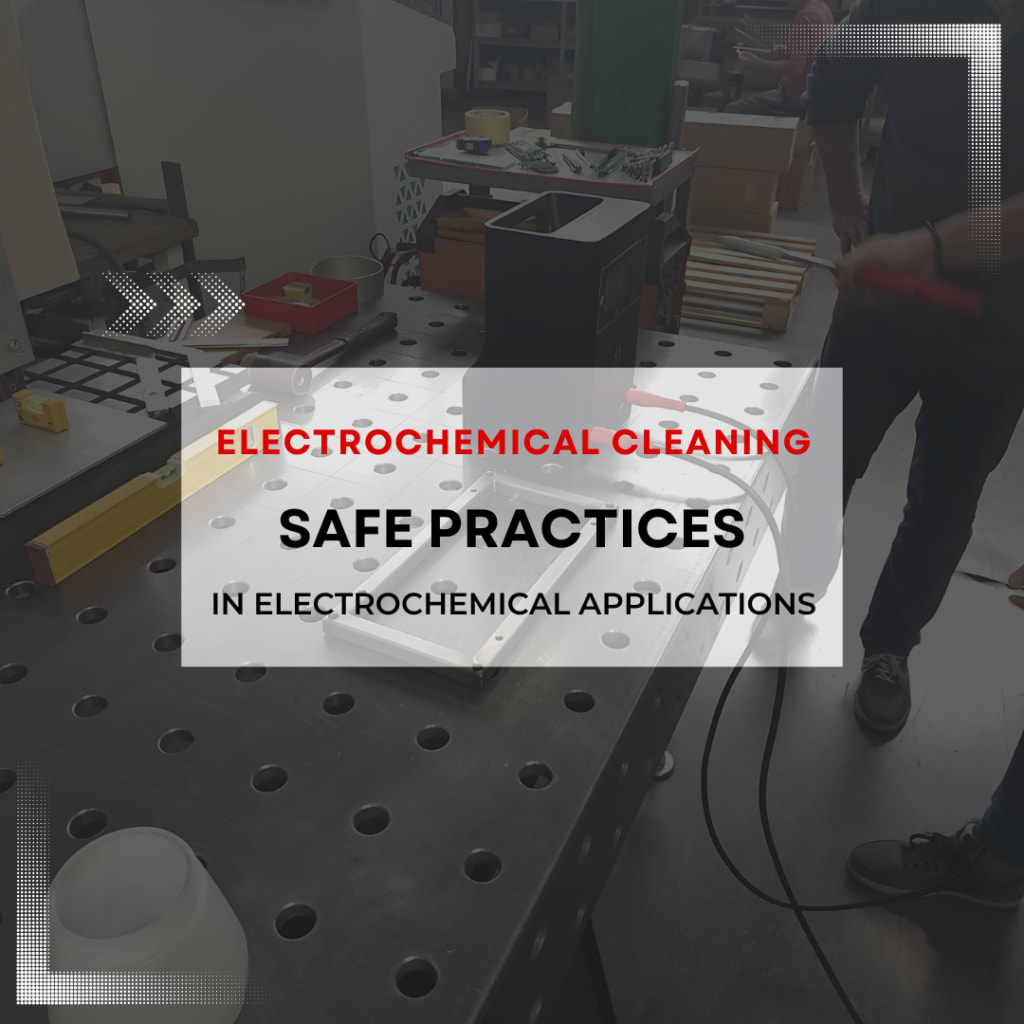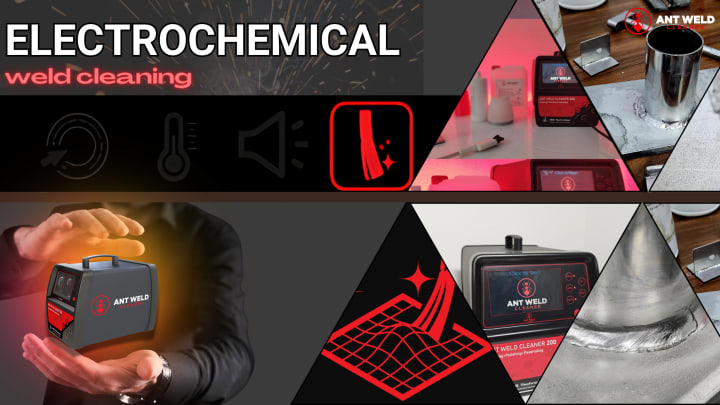Electrochemical Cleaning: Ensuring Safe Practices in Electrochemical Applications
Electrochemical processes are integral to numerous industrial and laboratory applications, ranging from battery manufacturing and metal plating to electrolysis and corrosion prevention. While these processes offer significant benefits, they pose various safety risks if not handled properly.

This blog will explore the principles of electrochemical safety, the potential hazards involved, and best practices to ensure a safe working environment.
STAY SAFE!
Understanding Electrochemical Processes
The field of electrochemistry deals with the study of chemical processes that involve the movement of electrons through an external circuit and ions through an electrolyte. These electrochemical processes have wide-ranging applications in various fields, including energy storage and conversion, corrosion prevention, sensors, and electroplating.
Electroplating: Depositing a metal coating onto a surface.
Electrolysis: Splitting compounds, such as water, into hydrogen and oxygen.
Battery Operation: Storing and releasing electrical energy.
Corrosion Protection: Using cathodic protection to prevent rust.

Potential Hazards in Electrochemical Applications
Before starting work on an electrochemical application, several factors should be carefully considered. These include the selection of appropriate electrodes and electrolytes, the potential for corrosion, the efficient use of energy, the possibility of side reactions, and the overall safety of the electrochemical process. It’s crucial to consider these factors to ensure that electrochemical applications are implemented successfully and safely.
Electrical Hazards
Electric Shock: Direct contact with electrical circuits can cause severe injuries or fatalities.
Short Circuits: Faulty wiring or equipment can lead to short circuits, resulting in fires or explosions.
Chemical Hazards
Chemical hazards present significant risks to both human health and the environment. Understanding various chemicals’ properties and potential dangers is crucial for preventing accidents and minimizing harm. Before starting working with electrochemical applications, always explore the different types of chemical hazards, their effects, and essential safety measures to mitigate the associated risks.
Corrosive Chemicals: Electrolytes in electrochemical cells can be highly corrosive due to their acidic or alkaline nature. When they come into contact with skin or eyes, they can cause chemical burns and damage. Handling them carefully and using appropriate safety equipment, such as gloves and protective eyewear, when working with these substances is important.
Toxic Gases: Some electrochemical reactions can produce toxic gases, such as chlorine or hydrogen sulfide, posing inhalation risks.
Thermal Hazards
Thermal hazards refer to potential risks and dangers associated with heat, such as burns, overheating, or fire. These hazards can arise from hot surfaces, open flames, hot liquids, or steam. Exposure to thermal hazards can result in serious injuries, so it’s crucial to be aware of proper safety protocols and precautions when working in heat or hot environments.
Understanding thermal hazards and implementing safety measures can help prevent accidents and protect individuals from harm.
Overheating: Excessive current or faulty equipment can cause overheating, leading to burns or fires.
Exothermic Reactions: Some electrochemical reactions release significant heat, which can cause burns or ignite flammable materials.
Mechanical Hazards
Mechanical hazards in the workplace can pose serious risks to employees’ safety, such as moving machinery parts and equipment with sharp edges. Employers are responsible for assessing and mitigating these hazards to ensure a safe working environment for their employees.
Proper training and protective measures, such as guards and personal protective equipment, are essential in preventing injuries related to mechanical hazards.
Explosion Risks: Improper handling of electrochemical cells, especially batteries, can lead to explosions due to internal short circuits or gas build-up.
Pressure Build-up: Sealed electrochemical cells can build up pressure, potentially causing them to rupture.
💡 Discover the advantages of using electrochemical weld cleaning in our blog here.
Best Practices for Electrochemical Safety
Personal Protective Equipment (PPE): PPE stands for Personal Protective Equipment. It refers to protective gear, clothing, helmets, goggles, or other garments or equipment designed to protect the wearer’s body from injury or infection. PPE is commonly used in healthcare settings, industrial workplaces, and other environments where exposure to hazardous materials or physical harm may occur.
Gloves: Use chemical-resistant gloves to protect against corrosive electrolytes.
Safety Goggles: Wear goggles to prevent chemical splashes from reaching the eyes.
Lab Coats and Aprons: Protective clothing protects the skin from chemical exposure.
Respirators: Use appropriate respiratory protection in environments where toxic gases are at risk.
Equipment and Facility Safety
Equipment and facility safety is essential to prevent accidents and injuries in the workplace. Proper training, regular inspections, and maintenance of equipment and facilities are crucial to ensuring a safe working environment for all employees.
By following safety protocols and using equipment correctly, we can minimize the risk of accidents and create a secure workplace for everyone.
Proper Ventilation: Ensure adequate ventilation to disperse toxic gases and prevent accumulation.
Insulated Tools: Use insulated tools and equipment to minimize the risk of electric shock.
Grounding and Bonding: Properly ground and bond electrical equipment to prevent static discharge and short circuits.
Regular Maintenance: Conduct regular inspections and equipment maintenance to ensure optimal working conditions.
Safe Handling and Storage of Chemicals
Safe handling and storage of chemicals is crucial to prevent accidents and ensure the safety of individuals and the environment. Proper labelling, adequate ventilation, and appropriate storage containers are essential. Additionally, it’s important to have clear guidelines for handling and disposing of chemicals to minimize risks and maintain a safe working environment.
Labelling: Clearly label all chemicals and electrolytes, including hazard information.
Storage: Please store chemicals in suitable containers and conditions and keep them away from incompatible materials.
Spill Management: Have spill containment and neutralization materials readily available.
Safety Training and Procedures
Training and procedures ensure employees have the necessary skills and knowledge to perform their jobs effectively and safely. Proper training equips employees with the tools they need to excel in their roles, while established procedures help maintain consistency and compliance within the organization.
By investing in comprehensive training and clearly defined procedures, businesses can boost productivity, minimize errors, and create a safer work environment for all employees.
Employee Training: Provide comprehensive training on electrochemical processes’ hazards and safety measures.
Standard Operating Procedures (SOPs): Develop and enforce SOPs for handling, storing, and disposing of chemicals and for operating electrochemical equipment.
Emergency Procedures: Establish and communicate emergency response procedures for incidents such as spills, fires, or electrical accidents.
Safety Monitoring and Controls
Monitoring and controls are essential components of any system or process. Monitoring involves observing and measuring the performance or behaviour of a system to track its progress and detect any changes or issues.
Controls refer to the mechanisms or actions used to manage, direct, or regulate the behaviour of a system to ensure it operates within specified parameters or achieves desired outcomes. Both monitoring and controls are critical for maintaining efficiency, identifying problems, and making informed decisions in various domains such as technology, finance, and manufacturing.
Safety Sensors: Use sensors to monitor gas leaks, temperature spikes, and electrical faults.
Control Systems: Implement automated control systems to manage and mitigate real-time risks.
Regular Audits: Conduct safety audits and risk assessments to identify and address potential hazards.
Conclusion
Electrochemical processes offer numerous benefits across various industries but also have significant safety risks. By understanding the potential hazards and implementing best practices, you can ensure a safe working environment and prevent accidents. Proper training, use of personal protective equipment, regular equipment maintenance, and adherence to safety procedures are crucial components of electrochemical safety. Prioritizing these measures will help protect workers and facilities while maximizing the benefits of electrochemical applications.

About the Creator
Ant Weld Cleaner
Explore the world of welding with our informative and innovative blogs! Stay up to date with the latest developments.
Say yes to NON-TOXIC technology!
Enjoyed the story? Support the Creator.
Subscribe for free to receive all their stories in your feed. You could also pledge your support or give them a one-off tip, letting them know you appreciate their work.






Comments
There are no comments for this story
Be the first to respond and start the conversation.